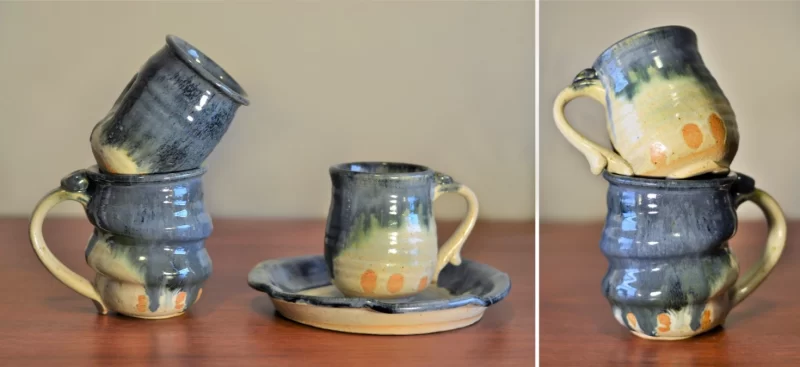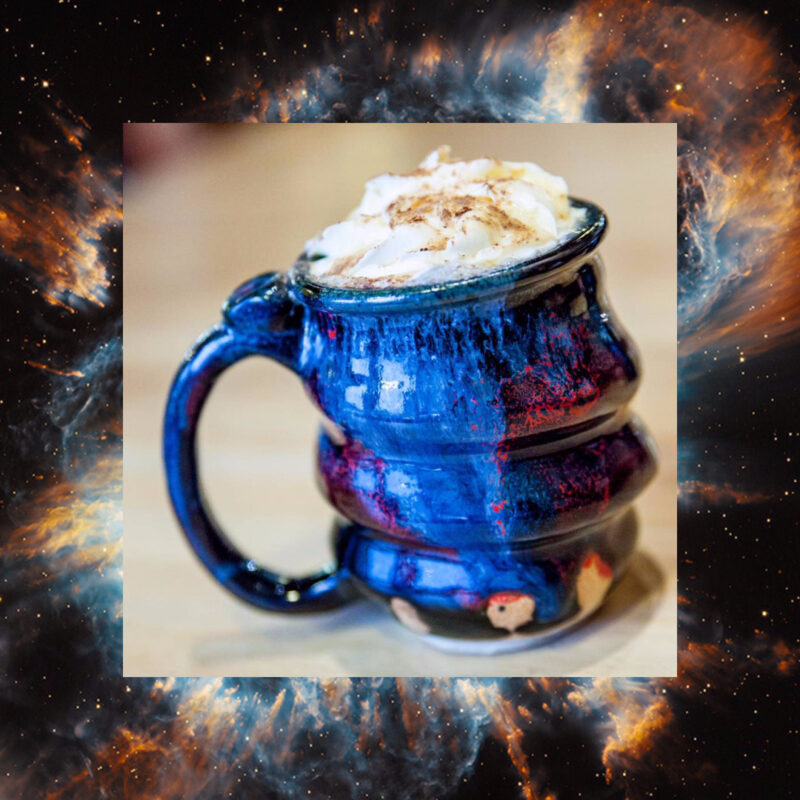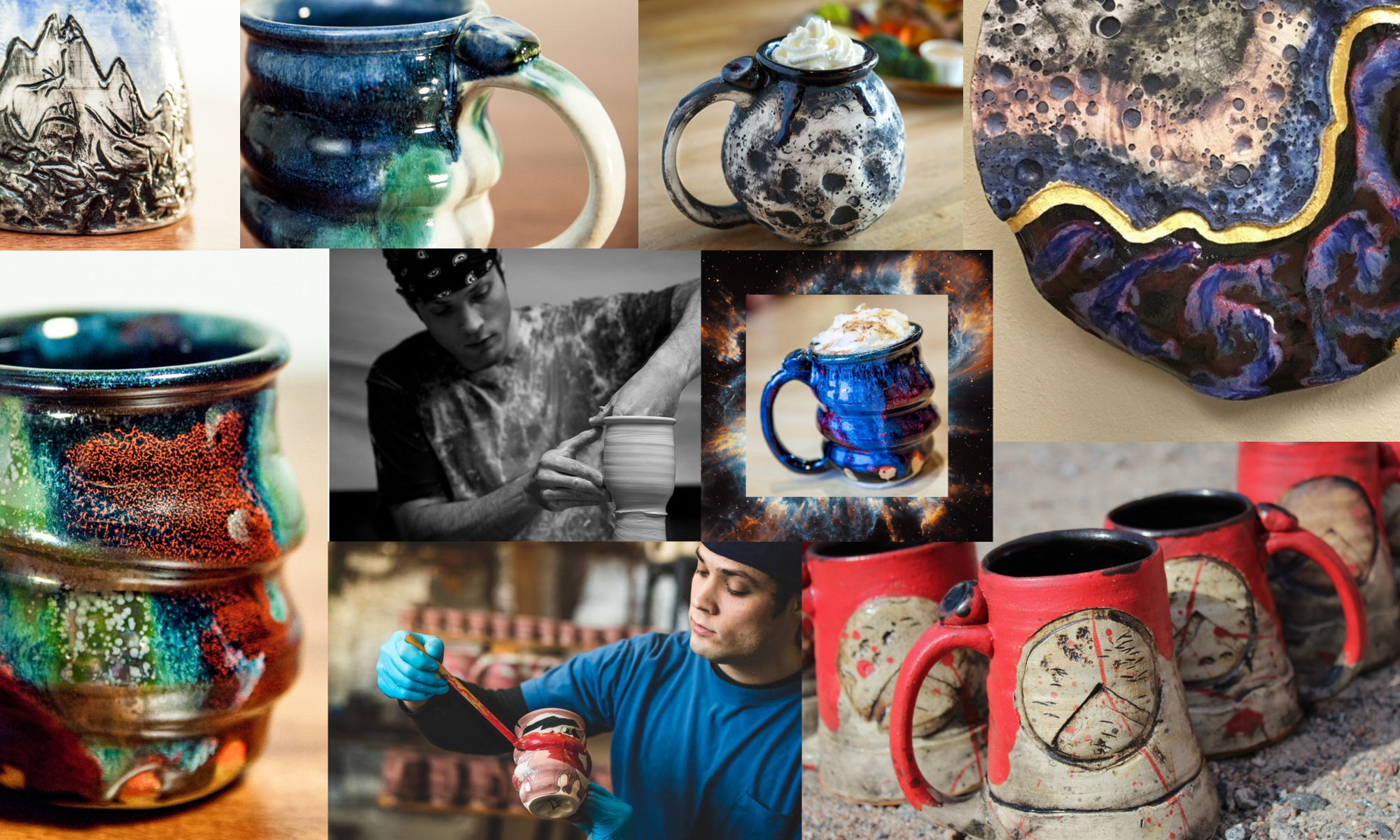The video above explains everything. Cobalt human rights violations, which are happening right now and likely to increase, are unacceptable. I refuse to sit by and do nothing.
The best thing I can do to help solve these horrific problems is to talk about them publicly to our hundreds of thousands of followers, and minimize my use of cobalt blue.
I’m discontinuing this pottery, effective immediately, until further notice:
I will try to reformulate glaze chemistry to get blue without cobalt, but it’s unlikely I’ll succeed.

Blue Spiral Cosmic Mugs

There is also pottery that contains cobalt that I’m not able to discontinue today. For those pots, I’m working to reformulate my custom glaze chemistry to eliminate cobalt, but maintain beautiful blue colors. Those include any pot that has my custom “Oil Spot Black” glaze, specifically the “Cosmic” glossy black pottery, including all Cosmic Mugs and Moon Mug interiors for cosmicmugs.com.
Here is the exact glaze recipe for my Cosmic Mugs, with how much cobalt I use today.
Oil Spot Black, Cone 6-10
| Silica 325 mesh | 17.4 |
| EPK (Kaolin) | 8 |
| Calcium Carbonate, High Purity | 13.6 |
| Custer Feldspar | 47.4 |
| Bentonite | 4 |
| Red Iron Oxide | 8.1 |
| Cobalt Oxide | 2.5 |
| Total | 101 |
Some of my pottery will still require cobalt, like the Neptune Mugs, which I make about 100 of per year. But for the other 5,900 pots I make per year, my goal is to eliminate cobalt entirely. I can’t guarantee I’ll succeed, but I’ll try.
Do you know an ethical source of “Cobalt Oxide” powder available for purchase? Please reach out to us anytime if you discover any solutions to this problem: contact@cherricopottery.com

New blue pigment
Featured snippet from the web
And now, for the first time in two centuries, a new chemically-made pigment of the celebrated color is available for artists — YInMn Blue. It’s named after its components — Yttrium, Indium, and Manganese — and its luminous, vivid pigment never fades, even if mixed with oil and water
This is exciting 🙂 Do you know if this is available as a ceramic pigment atall?
You are an awesome human being! I have one of these mugs. I can’t wait to see what your creative mind comes up with instead! Here’s to activism that makes a different in our world!
This is a great opportunity to play with other colors. Not being a “blue” person, looking forward to light Sandy colors w reds, greens, oranges.
Julie
I admire you for your stand on the use of cobalt from the mines in Africa. Last month the topic of the conditions in the mines was covered on NPR. Seeing the visual of the people working in that pit was startling and heartbreaking. Thank you for your stand.
I love that you are standing up to this horrible situation in the Congo.
Wow I am so moved by your willingness to make this stand esp as it effects you financially. And I appreciate that you are educating others as you do it. I am glad to hear of Cobalt Red and also commit to educating those around me and becoming more of an advocate for change. Thank you Joel
I have just been googling this very subject! As I love the blues that cobalt oxide produces in pottery and desperately want to make blue pottery but do not want to be harming the environment. Having read a few articles, I came across this a very good one which stated that Cobalt oxide from Potclays is ethically sourced. To my relief, I found that the Cobalt I had purchased was from there. Looking more closely at the Potclays product listing, there is a link to their cobalt supplier with further details and certicatiom, so I think it looks OK, potentially…. If you do find some ways of making bright blue without cobalt, do you plan to share your discoveries with the ceramics world? I’d be very interested to phase out cobalt as much as possible too if there are other ways of getting good blues. Best regards, Hannah
Thank you, Hannah. Unfortunately, I took a close look at their evidence of ethical cobalt sourcing, and in my opinion it was not convincing, at all. It has been a year since Siddharth Kara’s bestseller, “Cobalt Red: How The Blood of the Congo Powers Our Lives” was published. Siddharth goes to the Congo himself. Yesterday, he posted a video to his Instagram of children in the Congo selling cobalt. He said this a year ago, and it seems to ring true today: “There is no ethical cobalt.”
Oh no – how gutting! 🙁 Presumably this might affect a lot of blue paint and dyes as well… !!
http://jillrutter.com/ceramics/cobalt-suffering-for-beauty This isn’t he article I read 🙂
Ethical cobalt I think…. https://www.potclays.co.uk/cobalt-oxide#responsiveTabs
They’re trying to source ethically, but the more I explored their evidence, and all evidence, the less convinced I am that this is truly sourced ethically.